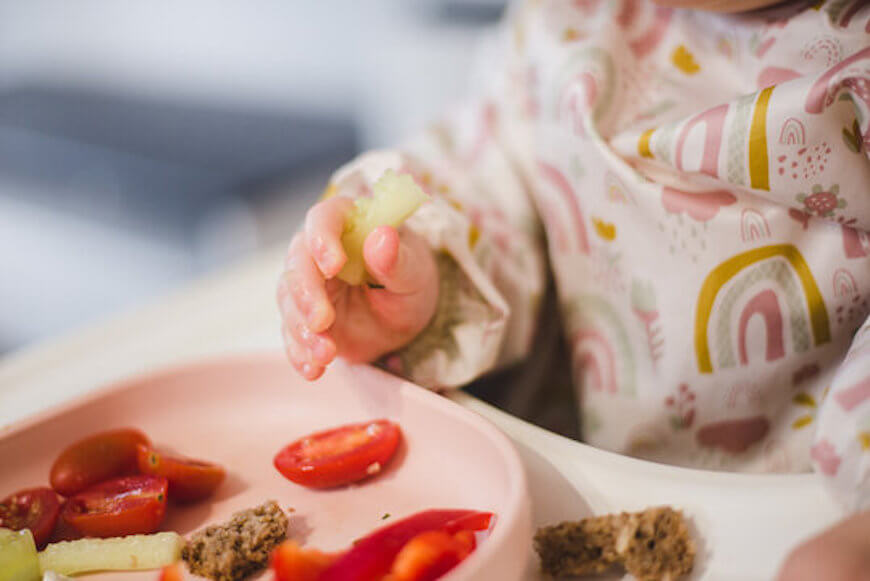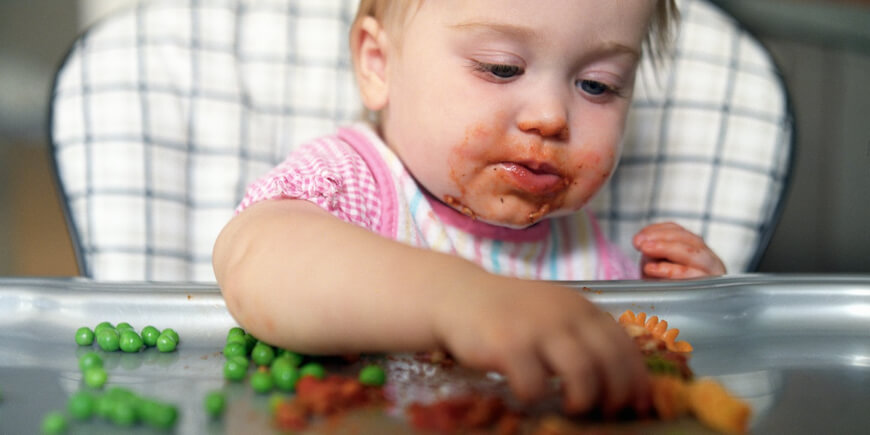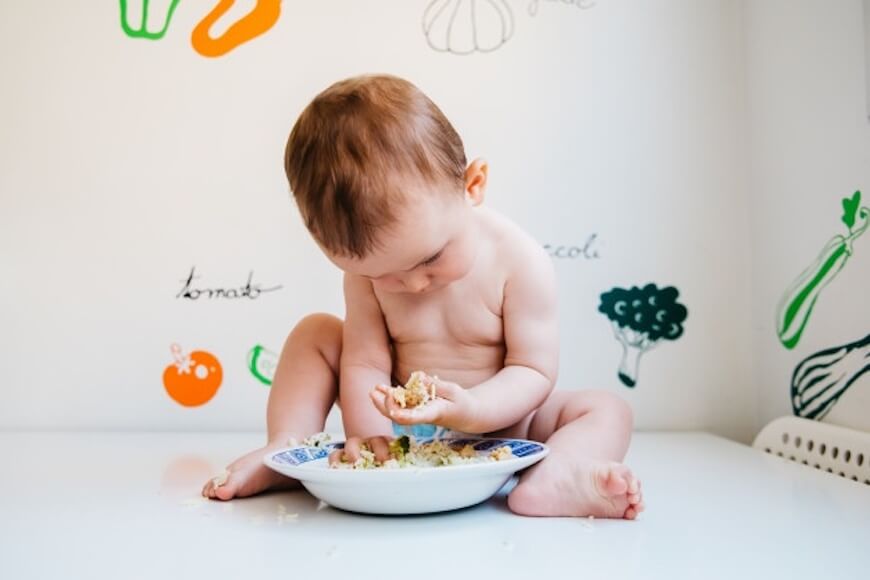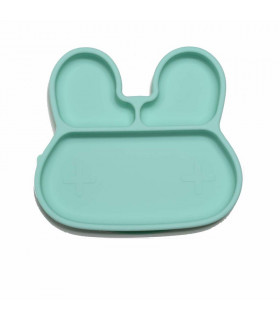Baby-led Weaning (BLW), what you need to know
Named by a nurse from England, Baby-led weaning (BLW) appeals to more and more young parents. This practice consists of providing autonomy to the child when discovering foods. Want to learn more about this increasingly popular method? Here's a close-up on everything you need to know.
What is the principle of baby-led weaning?
Baby-Led Weaning is an approach based on a simple principle, which is that of letting children discover solid foods on their own starting at the age of 6 months. It is also known as autonomous feeding and owes its name to Gill Rapley, doctor of pediatric nutrition. She is indeed considered the mother of this approach in that she was the first to name it by the term "Baby Led Weaning".
Autonomous eating is a counter to the so-called classic food diversification. It boils down to the introduction of solid foods useful for the development of a child's jaws. The latter has the freedom to take the pieces alone and put them in his mouth at his own pace. It goes without saying that with this approach, the child is using his hands rather than a spoon. In addition, compotes and purees are abandoned in favor of solid foods. Foods must be identifiable and separated. A compartmentalized baby plate makes this easier.
The other characteristic of independent feeding remains the freedom given to the baby as the intervention of the parents is considerably limited. Beyond the playful aspect, this approach stimulates the child's motor skills to the extent that he or she is called upon to feed himself.

What are the advantages of autonomous feeding?
Like the classic approach, independent feeding familiarizes babies with new textures, smells and the various forms that food can take. Also, your little one will have the opportunity to discover flavors and tastes independently.
In addition, your toddler can eat dishes identical to those of adults in the family in his or her baby suction plate. This alleviates the burden on the parents who will only have to prepare a single meal. Note, however, that the baby may express reservations about certain foods such as meats, fried foods and sweet or savory dishes. It will then be necessary to concoct a particular dish for them in this case, to let them eat alone in a baby bowl with suction cup or a baby plate with suction cup.
Independent feeding also weakens the baby's eye-hand and hand-mouth coordination. It helps them better control their hunger signals as they eat at their own pace and only when they decide they need it. He or she learn all on their own to manage their own satiety.
Concretely, BLW is gaining popularity for more than one reason:
- The baby is introduced to chewing early
- You limit the supply of products from the food industry such as compotes or purees
- The risks of food refusal during the child's 2 or 3 years are considerably reduced
- Your baby quickly masters the notion of satiety
- It promotes language learning
Finally, independent feeding is a relevant alternative for babies who are less favorable to purees.
At what age can you start baby independent eating?
Usually, you know that your child can start independent feeding when he or she is about 6 months old. During this period, they get better control of their movements, especially those of their tongue. Certain baby habits make it possible to identify the ideal time to initiate independent feeding. So you can start when:
- The new baby is able to sit without support for many minutes. He will indeed have to sit on a high chair
- The child is 6 months old (for premature babies, please calculate according to the corrected age)
- The baby is able to pick up an object and point it at his mouth
- The toddler may shake their head from side to side in denial, then up and down.
- The child can nibble on objects
Also, he should show an interest in the meals you eat, your toddler will especially want to eat from the adult plates. So remember to take a plate that sticks to the table fom him or her, and take to get ergonomic baby cutlery to learn how to eat. Even if they in the end only use their hands.
However, when your treasure has coordination problems, a malformation in the mouth such as a cleft palate, independent feeding is not recommended. The same goes for a child with delayed motor development.

What foods can you introduce and in what shape?
As in the conventional approach to food diversification, certain guidelines must be observed in terms of independent nutrition.
What composition of meals and what foods?
While there is no need to be complicated when it comes to eating independently, meals should still include a variety of foods such as:
- One or more vegetables as well as a very ripe or soft fruit
- Eggs, fish or meat (in very small pieces) because of their high iron content
- Legumes such as lentils and beans from the age of 8 or 9 months
- Breast milk or dairy products such as yogurt, cheese or cottage cheese
- A starch-based food (Potatoes, bread, pasta, etc.)
- A fat of plant origin such as avocado or nut butter
- Baby cereals
What size and shape of food should you make for your baby?
The shape of the food is essential for a successful approach, it will be necessary to take into account the ease of gripping by the baby. Thus, you will have to present the dishes in special formats, namely:
- Stick shapes for well-cooked or tender vegetables (carrots, asparagus, peppers, etc.)
- The shape of a cube longer than 3 cm for tofu or cheese. You also have the option of grating them.
- The shapes of laces
- Bouquet shapes
- The shape of a dumpling or a half-moon
Legumes should be incorporated into recipes as a puree. As for the texture, make sure that the meal is melted once in your mouth. To make sure, place the food between your lips and then try to mash it. You can do the same between your palate and your tongue. If you can crush food, your child will do the same with their gums. Foods must be separated from each other, so that they can distinctly choose each taste. To prevent everything from mixing too quickly on their plate, opt for a plate with several compartments.
What size for food?
As for the size of the food, it should not exceed the size of your little finger. This will allow the food to be visible even when the child closes his fists. To facilitate the intake of food, bet on a size equivalent to that of the palm of the baby's hand.
- Between 6 and 7 months, bet on food in strips or sticks
- Around 8 months, choose foods the size of a golf ball
- Between 9 and 12 months, bet on foods the size of a dice
At around 9 months, you can offer the food in the form of large cubes or grated versions.

How should you start baby independent eating?
At first glance, it should be borne in mind that a baby does not have the same reflexes when it comes to a meal as an adult. Here are basically the useful tips for a successful BLW:
- Ask for the opinion of the pediatrician before getting started
- Present the meal in a baby suction plate and place the child on a high chair
- Introduce the meals to the child yourself to start. The intervention of the nursery or the grandparents is not recommended, at least in the early stages
- Place a cloth under the high chair and dress your baby with a long-sleeved bib for less constraints on cleaning
- Highlight a few pieces of food in front of him
- Spoons are to be avoided, as are mashed potatoes
- Take a portion of food in his dish and eat in front of him to stimulate him
- Be careful not to bring the food to the baby's mouth. He will be able to spit out excessively thick portions on his own.
- Offer the meals at a time when the child feels rested, after a nap for example
- Motivate the little one by offering him the food on your plate
- Favor a calm environment, ideally without another child around the table
- Expect the experience to be messy at first as the child will have to play with the food and put it everywhere
- The feeding time will be relatively long, it will be necessary to respect the rhythm of the child until he adapts to the frequency of adults after about 12 months
In addition, the baby will eventually have to consume in small quantities at its beginnings, breast milk will be able to compensate for the majority of its needs. Don't be dissapointed if he or she only eats a little. On the contrary, congratulate them for taking the courage to try out on their own.
What foods should you avoid?
While BLW limits the risk of choking, certain foods are not recommended, namely:
- Unpeeled or thin-peeled vegetables and fruits
- Small or round foods such as whole grapes or sausages
- Partially cooked or raw foods (meat, eggs, fish, etc.)
- Whole nuts or peanuts
- Meals based on salt or sugar
- Hard foods in raw form (carrots, celery, broccoli, etc.)
- Sticky food with a pasty consistency (dried fruit, sandwich bread, flat bread, raw spinach, lettuce, etc.)
Before he is 12 months old, be careful not to give honey to your child to prevent any risk of infant botulism. It is a rare and fatal disease affecting toddlers under one year of age.
You know a little more about baby led weaning and the recommendations for its success. Remember that it is essential to give your little treasure time to find his or her own rhythm. If you have any concerns, do not hesitate to seek help from a pediatrician or a nutritionist.






